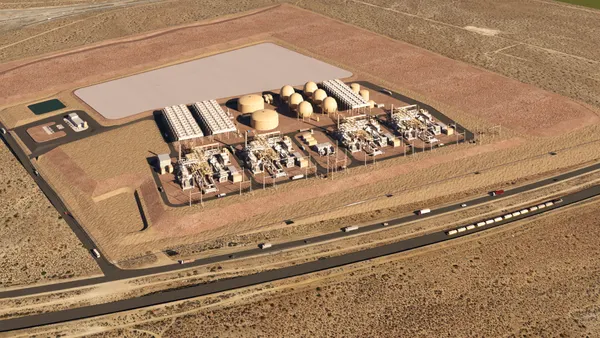Dive Brief:
-
Utility-scale deployments are likely to drive growth in the storage sector over the next several years, especially as costs decline, industry experts said at the Solar Power and Energy Storage Mountain West conference in Denver last week.
-
Analysts from Wood Mackenzie predict that the global storage market will expand from 4 GW of annual deployments in 2019 to more than 15 GW in 2024. In the U.S., the market for distributed versus utility-scale storage will vary depending on location and the cost of retail power, but on a megawatt capacity, growth will be primary in utility scale, according to Thad Kurowski, senior policy advisor at Tesla.
-
But financial experts say they are still not seeing as many storage projects as they would like to invest in. "Every year has been sort of the year of storage and we just haven't seen it," Eric Barr, business development associate at U.S. Bancorp Community Development Corporation, said at the conference.
Dive Insight:
It's good to think of energy storage as a Swiss Army knife, Ján Porvaznik, director of energy storage at RWE Renewables, said at the conference — some research points to over 130 different use cases for the technology. But today, "we're not there yet with using that Swiss Army knife to its full capacity," he added.
Cost reductions of 40% over the last four years have given the storage sector its competitive edge, and storage technologies and capabilities are continuing to improve, he said. However, stakeholders need to look at reducing the "pretty substantial" cost of integrating storage resources, to get to a point where it can be deployed at scale.
Dropping costs, renewables targets and direct incentives are all pushing the growth of energy storage, according to analysts at Wood Mackenzie, and manufacturers, developers and investors will likely be competing for a portion of the market over the next decade.
Looking to 2030, the analysts expect more mature supply chains and market players, but also a higher potential for disruption from new storage technologies as well as future regulation.
"The energy storage industry is in the enviable position of juggling growth gamechangers from multiple directions. Plunging costs drove speculation in the first scaled markets but as price declines enter a steadier rate, further recognition of storage's value — rather than cost — will be the key factor in determining growth," Daniel Finn-Foley, head of storage at Wood Mackenzie, said in a press release.
Utility-scale, residential as well as commercial and industrial (C&I) storage deployments all have a lot of potential for growth — but utility-scale will likely represent the bulk of the market, panelists said at the conference. C&I demand, meanwhile, is likely to stem from the value of energy arbitrage — like in California, where time-of-use rates provide the perfect case for C&I customers to look into storage solutions, Porvaznik said.
"So there's a bright future for all these applications, I just think that the large-scale will see the higher market in the near future," he added.
On the residential front, Xcel Energy has seen about a couple of hundred applications over the last two years, Beth Chacon, director of grid strategy integration and innovation at the utility, said. The utility doesn't vary rates at different times of the day, so there's no real value for energy arbitrage — but a lot of the systems are being used for back-up power, she said.
"There's a potential with time-of-use rates coming for the battery to help manage some of that customer value there but again, it's not quite enough to justify an investment in batteries, but maybe over time that's something that will change," she said.
From a financing perspective, investors have not yet seen the influx of storage projects that they would like to, Nick Perugini, vice president of project and partner development at Solaris, said at the conference. He's seen a couple of projects come across his desk but hasn't yet financed any, he added.
Solar financing firm Wunder Capital has not done as much storage as they'd have liked, but are "very excited" about it, CEO and co-founder Dave Riess said. Historically, the company has done transactions predominantly in Hawaii and California and is now starting to see more standalone storage opportunities come out of the Northeast.
MMA Energy Capital has done a couple of solar-plus-storage projects, where storage is a very small component, Vice President Danielle Thompson said, adding, "We do have standalone storage in our pipeline right now, but have not yet financed one."
The silver lining is that the financial community has more time to prepare for a potential storage wave than it has had for other emerging trends, according to Barr.
"I think from our underwriting perspective, we're ready for it — we have a platform," he said.













